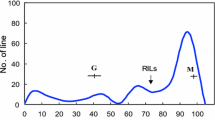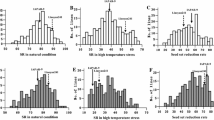Abstract
Quantitative trait loci (QTL) for the length of the dehiscence that forms at the base of the anther [basal dehiscence length (BDL)] in rice (Oryza sativa L.) were analyzed using chromosome segment substitution lines (CSSLs) developed from 9311 (as the recipient) and Nipponbare (as the donor). Using composite interval mapping with QTL Icimapping software, seven QTLs were detected on Chr. 2, 7, 8, 9, 10, and 11. These QTLs explained 6.49–18.15 % of the total phenotypic variation for BDLin CSSLs during 2012. qBDL8, qLDB10 and qBDL11 were derived from 9311 allele. The other four QTLs had negative effects on BDL and were derived from Nipponbare alleles. qBDL2-2, qBDL7, qBDL8, qBDL10 and qBDL11 were consistent with some heat tolerance QTLs mapped with different indexes and populations by other researchers. Among them, qBDL2-2 and qBDL10 were found to have significant effect on heat tolerance in populations derived from Nipponbare in previous reports, which suggests that those two QTLs were stable in different environments and can be used in heat tolerance breeding. The results indicated that QTL analysis of the long basal dehisce trait might be an effective index to identify the heat tolerance of rice in an ordinary environment.






Similar content being viewed by others
References
Cai W, Morishima H (2002) QTL clusters reflect character associations in wild and cultivated rice. Theor Appl Genet 104:1217–1228
Cao LY, Zhao JG, Zhan XG, Li DL, He LB, Chen SH (2003) Mapping QTLs for heat tolerance and correlation between heat tolerance and photosynthetic rate in rice. Chin J Rice Sci 17(3):223–227 (in Chinese with English abstract)
Chen WW (2010) The identification and analysis of heat induced proteins in night-temperature resources of Rice. Master Degree Thesis of Huazhong Agriculture University (in Chinese with English abstract)
Chen M, Xiao X, Zhang XQ, Yi ZH, Xiao CL (2012) Research on high temperature resistant characteristics of male parent of hybrid rice with largespike. Crop Res 7:1–4 (in Chinese)
Churchill GA, Doerge RW (1994) Empirical threshold valuesfor quantitative trait mapping. Genetics 138:963–971
Craufurd PQ, Jagadish SVK, Wheeler TR, Horie T (2007) Heat tolerance at flowering. An International Workshop on Cool rice for warm World. Wuhan, China
Das S, Krishnan P, Nayak M, Ramakrishnan B (2014) High temperature stress effects on pollens of rice (Oryza sativa L.) genotypes. Environ Exp Bot 101:36–46
Feng SZ, Liu HQ (2012) Effects of extreme temperature on photo-synthetic and physio-biochemical characteristics of indica and japonica rice seedlings. J Zhejiang Norm Univ Natl Sci 3:330–337 (in Chinese with English abstract)
Gong HB, Zhou YW, Li C, Hu CM, Diao LP, Lin TZ, Jing DD, Qian HF, Yu B, Sheng SL (2009) The influence of high temperature on seed rate of 63 indica restorer. Acta Agric Jiangxi 7:38–40 (in Chinese with English abstract)
Hao MM (2012) Functional analysis of a high thermo-sensitive leaf color mutant gene in rice (Oryza sativa L.). Master Degree Thesis of China Three Gorges University (in Chinese with English abstract)
IPCC 2014 Summary for policymakers. In: Field CB et al (eds) Climate Change 2014: Impacts, adaptation, and vulnerability. Part A: global and sectoral aspects. Contribution of working group II to the fifth assessment report of the intergovernmental panel on climate change. Cambridge University Press, pp 1–32
Jagadish SVK, Cairns J, Lafitte R, Wheelera TR, Pricec AH, Craufurd PQ (2010a) Genetic analysis of heat tolerance at anthesis in rice. Crop Sci 50:1633–1641
Jagadish SVK, Muthurajan R, Oane R, Wheeler TR, Heuer S, Bennett J, Craufurd PQ (2010b) Physiological and proteomic approaches to address heat tolerance during anthesis in rice. J Exp Bot 61:143–156
Jha UC, Bohra A, Singh NP (2014) Heat stress in crop plants: its nature, impacts and integrated breeding strategies to improve heat tolerance. Plant Breed 133:679–701
Kobayashi K, Matsui T, Murata Y, Yamamoto M (2011) Percentage of dehisced thecae and length of dehiscence control pollination stability of rice cultivars at high temperatures. Plant Prod Sci 14(2):89–95
Kui LM, Tan LB, Tu J, Lu YX, Sun CQ (2008) Identification of QTLs associated with heat Tolerance of yuanjiang common wild rice (Oryza rufipogon Griff.) at flowering stage. J Agric Biotechnol 16(3):461–464 (in Chinese with English abstract)
Lei DY, Chen LY, Li WX, Jiang Q, Zhang GL (2006) Effects of high temperature in flowering stage of hybrid rice on seed set and its related physiological characteristics. Hybrid Rice 3:68–71 (in Chinese with English abstract)
Lei DY, Tan LB, Liu FX, Chen LY, Sun CQ (2013) Identification of heat-sensitive QTL derived from common wild rice (Oryza rufipogon Griff.). Plant Sci 201–202:121–127
Li M, Ma J, Wang HZ, Wang RQ, Fu TL, Tong P, Wu HZ (2007) Relationship between some physiological and biochemical characteristics and heat tolerance at flowering stage in rice. Hybrid Rice 22(6):62–66 (in Chinese with English abstract)
Li PP, Cheng GF, Zhang JH, Li BB, Xie XJ, Yang S (2010) Effects of high temperature stress on physiological characteristics of during heading rice heading and flowering period. J Jiangsu Univ 31(2):125–130 (in Chinese with English abstract)
Mackill DJ, Coffman WR, Rutger JN (1982) Pollen shedding and combining ability for high temperature tolerance in rice. Crop Sci 22:730–733
Maestri E, Klueva N, Perotta C, Gulli M, Nguyen HT, Marmiroli N (2002) Molecular genetics of heat tolerance and heat shock proteins in cereals. Plant Mol Bio 5–6:667–681
Matsui T (2005) Function of long basal dehiscence of the thecae in Rice (Oryza sativa L.) pollination under hot and humid condition. Phyton 45(4):401–407
Matsui T, Omasa K, Horie T (2001) The difference in sterility due to high temperature during the flowering period among japonica–rice varieties. Plant Prod Sci 4:90–93
Matsui T, Kobazsai K, Kagata H, Horie T (2005) Correlation between viability of pollination and length of basal dehiscence of the theca in rice under a hot and humid condition. Plant Prod Sci 2:109–114
Matsui T, Manigbas NL, Redona E, Tian X, Yoshimoto M, Hasegawa T (2009) Heat-induced floret sterility in rice: mechanisms of occurrence and tolerance. Gamma Field Symp 48:43–49
McCouch SR, Cho YG, Yano M, PaulE Blinstrub M, Morishima H, Kinoshita T (1997) Report on QTL nomenclature. Rice Genet Newsl 14:11–131
Nadeau JH, Singer JB, Matin A, Lander ES (2000) Analyzing complex genetic traits with chromosome substitution strains. Nat Genet 24:221–225
Prasad PVV, Boote KJ, Allen LH Jr, Sheehyc JE, Thomasa JMG (2006) Species, ecotype and cultivar differences in spikelet fertility and harvest index of rice in response to high temperature stress. Field Crop Res 95:398–411
Satake T, Yoshida S (1978) High temperature induced sterility in indica rice at flowering. JpnJ Crop Sci 47:6–17
Shah F, Huang J, Cui K, Nie L, Shah T, Chen C, Wang K (2011) Impact of high-temperature stress on rice plant and its traits related to tolerance. J Agric Sci 149:545–556
Tazib T, Kobayashi Y, Koyama H, Matsui T (2015) QTL analyses for anther length and dehiscence at flowering as traits for the tolerance of extreme temperatures in rice (Oryza sativa L.). Euphytica 203:629–642
Tian X, Matsui T, Li S, Yoshimoto M, Kobayasi K, Hasegawa T (2010) Heat induced floret sterility of hybrid rice (Oryza sativa L.) cultivars under humid and low wind conditions in the field of Jianghan Basin. China. Plant Prod Sci 13:243–251
Wang QQ (2008) Effects of heat stress on rice fertilization and seed setting. Master Degree Thesis of Yangzhou University (in Chinese with English abstract)
Wang CL, Zhong WG (2004) Effects of high temperature on seed setting rate of rice and its prevention. Jiangsu Agric Sci 1:15–18 (in Chinese)
Wang J, Li H, Zhang L, Meng L (2013) Users’ Manual of QTL IciMapping. The Quantitative genetics group, Institute of crop science, Chinese Academy of Agricultural Sciences (CAAS), Beijing 100081, China, and Genetic Resources Program, International Maize and Wheat Improvement Center (CIMMYT), Apdo. Postal 6–641, 06600 Mexico, D.F., Mexico
Xia JF, Li ZF, Wang YL, Ma YC (2009) Evaluation method for heat tolerance of medium Indica rice in stage and its application research. Anhui Acad Agric Sci 37(36):17854–17856 (in Chinese with English abstract)
Xiao YH, Pan Y, Luo L, Zhang GL, Deng HB, Dai LY, Liu XL, Tang WB, Chen LY, Wang GL (2011) Quantitative trait loci associated with seed set under high temperature stress at the flowering stage in rice. Euphytica 178:331–338
Ye C, Argayoso MA, Redon ED, Sierra SN, Laza MA, Dilla CJ, Mo Y, Thomson MJ, Chin J, Delavin CB, Diaz GQ, Hernandez JE (2012) Mapping QTL for heat tolerance at flowering stage in rice using SNP markers. Plant Breed 131:33–41
Zhang T, YangL Jiang K, Sun HQ, Chen W, Zheng J (2008) QTL mapping for heat tolerance of the tassel period ofrice. Mol Plant Breed 6(5):867–873 (in Chinese with English abstract)
Zhang H, Duan L, Dai JS, Zhang CQ, Li J, Gu MH, Liu QQ, Zhu Y (2014) Major QTLs reduce the deleterious effects of high temperature on rice amylose content by increasing splicing efficiency of Wx pre-mRNA. Theor Appl Genet 127:273–282
Zhao ZG, JiangL Xiao YH, Zhang WW, Zhai HQ, Wan JM (2006) Identification of QTLs for heat tolerance at the booting stage in rice (Oryza sativa L.). Acta Agron Sin 5:640–644 (in Chinese with English abstract)
Zhao L, Kobayasi K, Hasegawa T, Wang CL, Yoshimoto M, Wan JM, Matsui T (2010) Traits responsible for variation in pollination and seed set among six rice cultivars grown in a miniature paddy field with free air at a hot, humid spot in China. Agric Ecosyst Environ 139:110–115
Zhao CF, Zhou LH, Yu X, Zhao QY, Chen T, Yao S, Zhang YD, Zhu Z, Wang CL (2012) Identification of tiller angle quantitative trait loci based on chromosome segment substituted lines and high-density physical map in rice. Bull Bot 47(6):1–8 (in Chinese with English abstract)
Zheng KL, Mackill DJ (1982) Effect of high temperature on anther dehiscence and pollination in rice. Sabrao J 14:61–66
Zhu CL, Xiao YH, Wang CM, Jiang L, Zhai HQ, Wan JM (2005) Mapping QTL for heat tolerance at grain filling stage in rice. Chin J Rice Sci 19(2):117–121 (in Chinese with English abstract)
Zhu CL, Jiang L, Zhang WW, Wang CM, Zhai HQ, Wan JM (2006) Identifying QTLs for thermo-tolerance of amylose content and gel consistency in rice. Chin J Rice Sci 20(3):248–252 (in Chinese with English abstract)
Zhu WY, Lin J, Yang DW, Zhao L, Zhang YD, Zhu Z, Chen T, Wang CL (2009) Development of chromosome segment substitution lines derived from backcross between two sequenced rice cultivars, indica recipient 93-11 and japonica donor Nipponbare. Plant Mol Biol Rep 27:126–131
Acknowledgments
This work was partly supported by the National Natural Science Foundation of China (Grant No. 31201181) and Jiangsu Agriculture Science and Technology Innovation Fund (CX[13]5004).
Author information
Authors and Affiliations
Corresponding author
Rights and permissions
About this article
Cite this article
Zhao, L., Zhao, CF., Zhou, LH. et al. QTL mapping of dehiscence length at the basal part of thecae related to heat tolerance of rice (Oryza sativa L.). Euphytica 209, 715–723 (2016). https://doi.org/10.1007/s10681-016-1664-8
Received:
Accepted:
Published:
Issue Date:
DOI: https://doi.org/10.1007/s10681-016-1664-8




